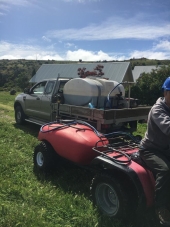












The ultimate goal of farming is not the growing of crops, but the cultivation and perfection of human beings. - Masanobu Fukuoka








 1
1




Seed the Mind, Harvest Ideas.
http://farmwhisperer.com








The ultimate goal of farming is not the growing of crops, but the cultivation and perfection of human beings. - Masanobu Fukuoka









Seed the Mind, Harvest Ideas.
http://farmwhisperer.com




Ken Peavey wrote:
I've made it in the shade-thats where the outlet is for the pump. I've seen it done in full sun.
The objective is to multiply a microbe population. UV radiation from the sun would not help you. Being the tea is in constant motion, I don't see UV as being a problem. I think the sunlight would also promote algae growth. If you are pumping water rather than air, this algae would pose the problem of clogging the pump.
I suggest you try a batch in the sun and a batch in the shade, compare the results. I would be interested in hearing your report.





Seed the Mind, Harvest Ideas.
http://farmwhisperer.com





































Seed the Mind, Harvest Ideas.
http://farmwhisperer.com








 ??
??Treehugger Organic Farms








Check out Redhawk's soil series: https://permies.com/wiki/redhawk-soil








This is all just my opinion based on a flawed memory





A human being should be able to change a diaper, plan an invasion, butcher a hog, conn a ship, design a building, write a sonnet, balance accounts, build a wall, set a bone, comfort the dying, take orders, give orders, cooperate, act alone, solve equations, analyze a new problem, pitch manure, program a computer, cook a tasty meal, fight efficiently, die gallantly. Specialization is for insects.
-Robert A. Heinlein

|
eat bricks! HA! And here's another one! And a tiny ad!
Play Your Way to a Sustainable Lifestyle: Uncover Permaculture Principles with Each Card
https://gardener-gift.com/
|




